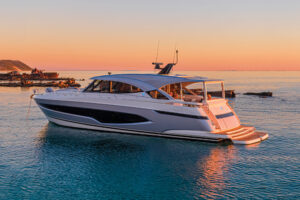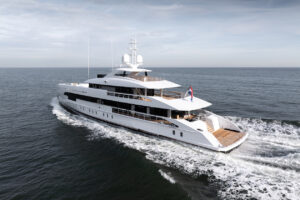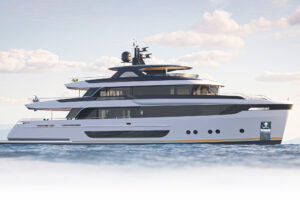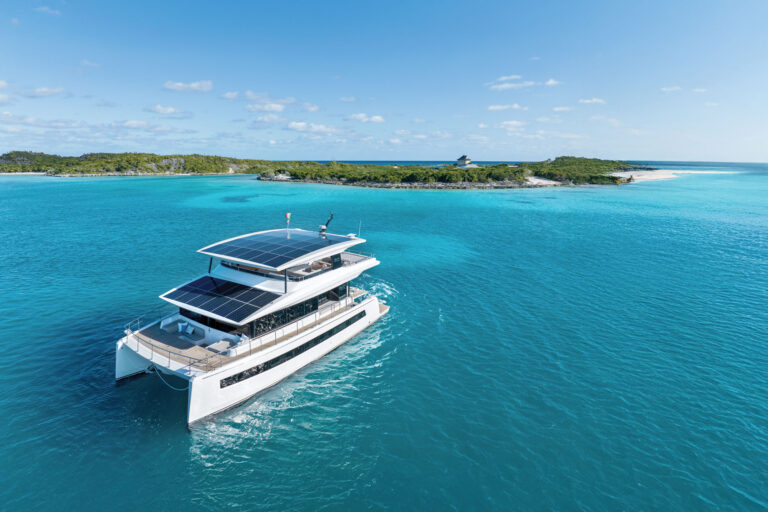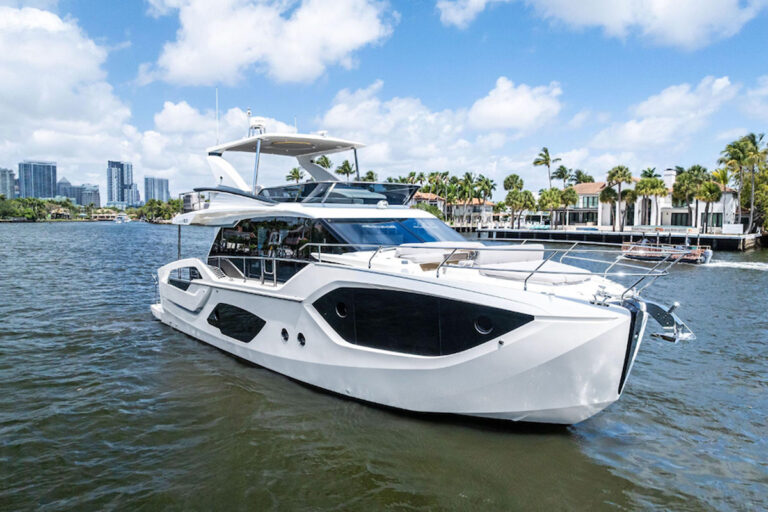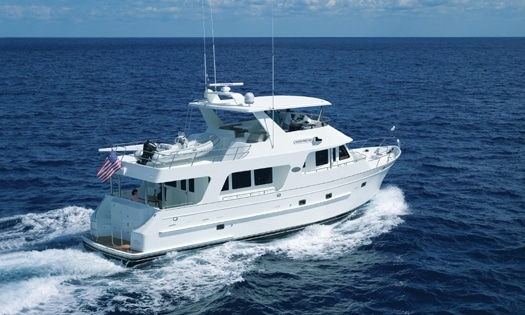
yachting/images/magazine/2006/112006/fea_outer_525x315.jpg
Ray and Susan Cope have cruised countless hours along both North American coasts, many of them aboard their previous yacht, a well-found 1987 DeFever 48 named Tortuga. Over the years, as they thought about what they wanted in their next yacht, the Copes did their homework regarding everything from freshwater purification systems to stabilizers, and developed a clear idea of the places they’d go and what they’d do there-and on board. They attended numerous boat shows and talked to every builder that offered passagemaking designs in the 50- to 70-foot range. And then they found the folks at Outer Reef Yachts, who convinced them that the new 65 they were planning to build was more in line with the size yacht they would be comfortable owning and operating as a couple. It didn’t take the Copes long to commit, even though the tooling for the 65 was not yet ready.
“We’d been aboard the 73 Outer Reef for only about 20 minutes when we realized that this was the builder we wanted to work with,” says Ray Cope, who approached the building of Outer Reef 65 Hull number one.
Cope calls Jeff Druek, president and CEO of Outer Reef Yachts, “a man intensely caught up in yacht building, the kind of guy who gives you 120 percent all the time.” He and Susan keep an album of pictures taken at the factory, and Druek figures in more than one, down in the hull or sitting on the sole of one of the many cabins, working with the staff to ensure that his customer’s needs are being met.
Jeff Druek built his first boat when he was 13, on Long Island, N.Y., putting it to work clamming; he wound up working in the commercial fishing industry. Following a stint in the Merchant Marine, Druek founded a construction company, which he has grown to include 120 employees building high-end homes in the Hamptons and other prestigious Long Island neighborhoods. But he never strayed far from his love of the water.
“I’ve always been a boat-a-year kind of guy, and have had three Sea Ray express-style yachts,” Druek admits, “but I knew that eventually I’d have to address a long-standing affinity for trawler-style boats.” He built his first trawler in collaboration with a Taiwanese yard about 10 years ago, eventually sold it and a second trawler, and then decided to get serious about building yachts. He launched the first Outer Reef 73 at the Miami International Boat Show almost three years ago. In the process he became a self-described fanatic about improving the designs he builds.
“On our 73, for example, from the day we started the tooling to the day we launched the first yacht, I made 173 changes to the design,” says Druek, “everything from moving outlets to swapping out fuel tanks.” This was a good foundation for the 65, although he readily admits that the learning process continued with that project, as well, and he wound up doing another 60 changes-which also bore fruit in subsequent 73s.
The Outer Reef 65 is built in separate tooling from the 73. Druek said that the 65 mold can be dammed to build a 60-footer, just as the 73 is built in the 80 mold. Hulls are hand-laminated fiberglass with PVC foam core above the waterline and a vinylester barrier below for osmosis protection. Druek is his own designer and draftsman for exterior and interior features, and he credits Chaucer Chen of the Tania Yacht Company in Kaohsiung, Taiwan, as the engineer and naval architect of record for all their yachts.
For Druek, the customer is always right, a reaction to approaching a well-known custom builder with a couple of minor changes, only to find that “they were not accommodating, would only build it their way.” That won’t happen with Druek’s customers, like the Copes, who will put 1,500 hours on their boat in a year. “Ray and Susan had specific ideas on the layout they wanted, so we worked together in our conference room for two days, with my laptop hooked up to the big screen. At the end of two days, we shipped the approved layout drawings to the yard for engineering drawings.”
Construction of each Outer Reef yacht is engineered up to and beyond where the boat will cruise. A careful, conservative client building an 80 has specified a Kevlar reinforced bow, plus an extra watertight collision bulkhead with a Freeman door to supplement the standard safety bulkhead. No problem for Druek, who also designed an oversize reinforcement system to accommodate the client’s request for a crane on the centerline of the extended boat deck, even though it would cancel out an open aft cockpit. “Most of our clients are pretty self-reliant, so whether you’re planning to go five miles or 500 miles offshore, you go prepared,” Druek says. Mission accomplished, the focus returned to building the best-looking pilothouse cruiser possible.
Hull number one, Copeing, is a stunning example of the yacht builder’s art. She was offloaded at Port Everglades in the spring, and christened during the Palm Beach Boat Show. When I saw her in September in Baltimore Harbor, her gelcoat was perfect, a brilliant white with molded planking stripes that sparkled and gleamed in the sun. “That’s the way it came out of the mold,” said Ray Cope. “The builders spent weeks prepping the mold before the hull lay-up began, and the resulting finish is flawless.” With five huge forward windows, three of which have oversize wipers, and long windows along both sides of the pilothouse, the Outer Reef 65 has excellent visibility from the lower helm. Though Ray says that he and Susan primarily operate from the flying bridge, they were not convinced that a hardtop was what they wanted; like most cruisers they had some concerns about the weight it might add up high. Given the yard’s successes with cored fiberglass, as well as the protection the hardtop offered them coming up the Atlantic Coast this spring and summer, they are delighted with their decision to add it.
Boarding from the transom, you’ll find teak planking underfoot, tall stainless steel U-shape stanchions for security, and twin molded stairways leading up to the cockpit. The extended boat deck, another feature the Copes decided on after talking to Druek and his sales team, protects the entire footprint of the cockpit, as well as the bench seat and table. “Outer Reef has created so much storage on this yacht,” Ray Cope said, opening locker doors handy to the transom gates, “we’re still learning where we want to put things.” Beneath a small hatch atop the portside locker next to the saloon bulkhead, he revealed a control station with a third set of Glendinning electronic engine controls and a joystick for the hydraulic bowthruster.
The watertight rear door swings open to reveal a cherry wood saloon lined with carefully book-matched teak veneer panels and flooded by natural light from three sides. A remarkable wood table, with two folding leaves that lay flush on top, sits in front of the L-shape settee. “A cruising friend has a similar table, and I liked its versatility for dining or entertaining, so I got on the phone with Jeff and he worked one up in no time,” says Susan Cope. In the closed position, the table has two birds-eye maple inserts, per Susan’s request; the yard surprised her by including the same insets on the top surfaces when the table, which seats eight, is completely open.
On the starboard side, just ahead of the two loose leather chairs selected independently of the other decor, is a liquor and glass cabinet the Copes requested in lieu of a small end table. The only thing the yard needed to know was the height of the tallest bottle they wished to store. An entertainment center replaces what was a breakfast bar with stools. Under the stairs leading from the pilothouse to the flying bridge, a specified pantry space flanks a wine captain and large refrigerator-freezer combo in place of the standard day head. Several other owners have since selected to have them installed on their yachts.
Some impressions of the interior remain prominently in my memory: Black granite graces the galley countertops, surrounded with plenty of overhanging cherry storage lockers and finished with a teak and holly sole. In the pilothouse, Ray Cope has specified an SSB for communications, e-mail and weatherfax for use in the Bahamas and Caribbean, as well as a chilled water air-conditioning system. A single Stidd 500XL with chrome base and Ultraleather upholstery fronts a broad console with room for a glass bridge. File cabinets flank the pilothouse bench seat, with two chart drawers built into the base just beneath the beautiful table. Instrument panels are found to port behind locker doors of solid teak.
The VIP cabin with its large island queen berth is located forward, while the guest stateroom to port has a double berth below and single berth above. The master stateroom amidships is full-beam, with two walk-in lockers, two more hanging lockers and numerous stowage cabinets. Finish on the inside of the lockers and closets duplicates the exterior finish, which is satin-soft and beautifully colored. Each stateroom has a private head and shower.
The engineroom is massive, with two watertight aluminum doors and more than enough room for working around both sides of the engines, which are mounted on massive sections of the full-length stringer system. Each engine has its own sea chest and is surrounded by stainless steel rails for safety under way. Large lights brighten the entire room, making it easy to spot oil leaks, and the entire room is lined with acoustic insulation.
L-shape bench seats on both sides of the flying bridge are equipped with high-low tables for entertaining, and there’s an outdoor kitchen to starboard with large grill, wash basin and ice maker. The view from the bridge is excellent all around, although the extension of the boat deck aft makes the addition of a lower station a wise choice for backing in.
If you see Ray and Susan Cope on the water, and you happen to be in the market for a new boat, chances are good that you’ll get a detailed tour of Copeing. They are satisfied customers, outspoken supporters of Outer Reef Yachts, and believers in the customer-satisfaction philosophy that drives Jeff Druek, the entire Outer Reef staff and the builders at Tania Yacht Company to greater heights.
Contact: Outer Reef Yachts; www.outerreefyachts.com

